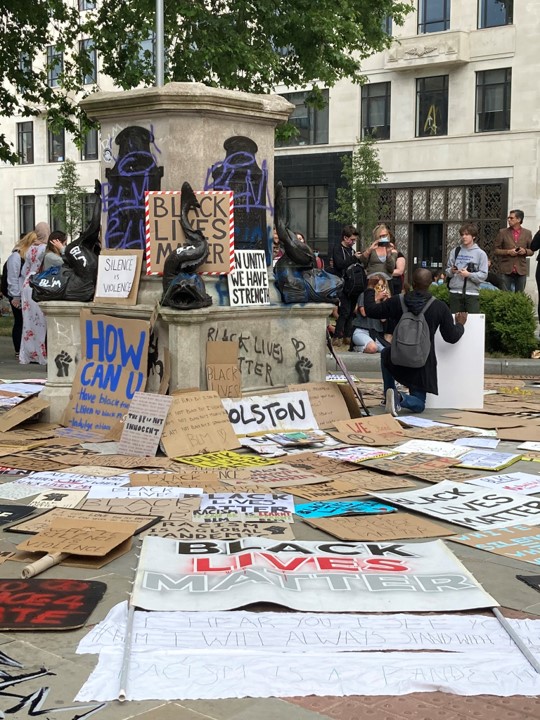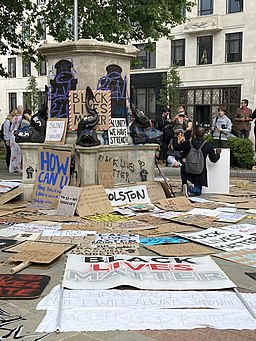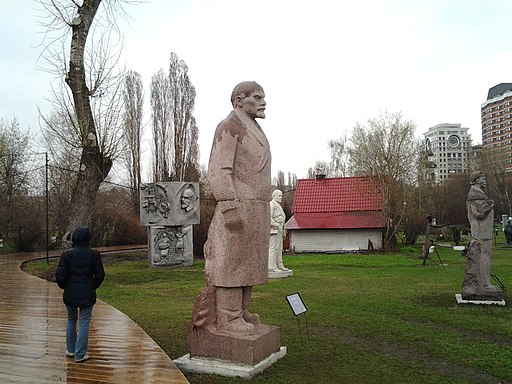Pedestals and pits

After years of daydreaming through deadly boring history lessons at school, full of dates, lists and dry information sheets, I dropped the subject as soon as I got the chance. Now, in later life, I’ve discovered a liking for it. History brings together two of my great passions – hearing stories, and discovering ‘why’. But when it comes to history, there are two things that really make my hackles rise.
One is when we view our history through rose-tinted glasses, as a chivalrous realm populated by national treasures. I grew up on stories of missionaries rescuing Chinese girls from the cruel and backwards practice of footbinding, the daring feat of the Dambusters helping to win the war, the tireless efforts of the West to promote peace in the Middle East. What a series of horrible shocks it was when the truth slowly emerged. When I found out that Britain sold opium to China and even fought two wars to protect the trade, all so they could buy tea more cheaply. That the Dambusters’ raid had little real effect against the Germans, while killing so many pilots, civilians and prisoners of war. And that while Britain promoted peace in the Middle East, they had played an instrumental role in the events that led to the whole mess.
My second aversion is to the destruction of historical objects. I find it hard to throw away even the sturdier varieties of packaging (I have boxes filled with ribbons cut from clothes and labels, and shelves cluttered with boxes and jars). When it comes to objects that someone spent time and effort to create, that have survived many years – even centuries – and are full of stories of the past, I find the idea of their casual destruction unbearable. The sight of the skip filled with my father-in-law’s cherished collection of old books after his death made me almost nauseous, and I still cannot think of the film of the Taliban blowing up the more than 1,500 year old buddha statues without experiencing a flash of vicarious pain.

The recent calls for removal and destruction of statues associated with slavery and colonialism have, therefore, left me with very mixed feelings, as they pit honesty about our past against care for our historical objects.
History is written by the winners. Statues are also usually erected by the winners, those with a good pocket full of cash and the right social connections. In sculpting a statue, the sculptor removes the flaws in the person’s appearance. Warts, spots, love handles, they all disappear. But in erecting a statue of a historical figure, we go further – we airbrush their character too. Statues are inherently noble: it is not for nothing that we use the word ‘statuesque’ as a positive adjective. So, these people must have been noble too: worthy, dignified, charitable, great in all their deeds. We put them on a pedestal – literally. We conveniently forget how they earned their money, how they treated their workers or their families, how many people died in the wars they instigated. They are our angels, placed high above us, soaring in the air. This attitude is perilous. If we blindly worship these people then we ignore their wrongs, increasing the chance that those wrongs will be perpetuated in our society. We also shut out the sufferings of their victims, leaving them to be forgotten.
I am glad, therefore, that the last weeks have seen an awakening to the truth in our past. I thoroughly understand the anger from those who have been ignored for so long as they tried to bring that truth to light, and from those who have recently discovered the dark underbelly of their nation’s past. That anger spurs people on to take action. Removing a statue is not the action I would choose, being purely symbolic, but the underlying change in attitude is a positive one.
However, I can’t approve of the destructive impulses that are now being given full sway. I believe a statue should be carefully removed, after proper discussion and public consultation. Given that this route had, in the case of the statue of Colston, been tried already for years without success, I can thoroughly understand people losing patience and taking action into their own hands. But toppling a statue is one thing – defacing it, smashing it, or throwing it into the harbour is another. Once a historical object is gone, it can’t be brought back again. Such objects are the physical embodiment of our collective history, and it is risky to allow one group to unilaterally destroy them based on their own sense of what is right. In the current cases, most of us believe racism is wrong, so it is tempting to see the destruction as intrinsically ‘right’. But there are many other controversial statues where the situation is far less clear-cut. Don’t forget that the Taliban also thought they were acting righteously when they blew up those Buddha statues.
Much as the destruction of statues bothers me, the real problem is how it doesn’t end the historical airbrushing, but instead continues it in a different form. Instead of our supposed angels returning to earth to be treated as humans and honestly evaluated, they are pushed even further, down into the pit, where they become a fallen angel, a demon. We close our eyes to anything good about them. All they were was a racist, a murderer, an abuser, an exploiter. They didn’t do any good, any possible achievements are forever tainted by their misdeeds. Praise their charitable work and you are implicitly condoning their racism.
But demonizing historical figures is as dangerous as idolizing them. Implicitly it supports idolization, as if someone who does wrong can never do good, then it follows that someone who does good could never do wrong. Also, if we don’t understand how these people contributed to society, then we can’t understand how it was possible that society permitted them to do wrong. That people may not have bothered themselves too much about what was going on in the overseas plantations of the friendly merchant who generously funded the local school. That the conservative man who believed women belonged at home could have been praised as a progressive liberal because he fought for (male) worker’s rights. That people voted for a charismatic dog-lover who promised to rebuild their country, unaware of the holocaust he would unleash. That nothing was said about slavery because it was part of normal life.
If we don’t learn these lessons from the past, then we won’t realise that these wrongs continue today. That we don’t concern ourselves with the conditions in overseas sweatshops as long as the fashion label projects a caring image. That hardworking, selfless charity workers nevertheless deny people information about safe contraception. That charismatic leaders can be capable of terrible deeds. That aspects of our own, “perfectly normal” behaviour may be things that our children will be deeply ashamed of in the future. In short, that wrong does not come in an easily identifiable package, but hides in all places, in all people.
Another problem with dividing history into simple groups of angels and demons is that it requires us to draw a line somewhere. But where? Once you start truly examining the person behind the statue, there is no one who stands up to the scrutiny. Robert Baden-Powell gave generations of children the joy of healthy outdoor Scouting activities, but admired fascism and read Mein Kampf, and was believed to be homophobic. Mother Teresa is honoured as a saint for her charitable work, but was criticized for regarding sickness and suffering as a gift from God, and for her stance against abortion and contraception. Martin Luther King was a hero of the civil rights movement, but limited his wife’s participation in that movement, and is suspected of having had affairs. Different groups of people will weigh up the good and bad of a given person in a different way. One person’s angel is another’s demon, one person’s hero is another’s villain. These polarisations make it very hard for us to find common ground. Such moral judgements are also far from permanent – a moral crusader acting in the mid-20th century might well have demanded Alan Turing’s amazing contributions to both computer science and the war effort be edited out of history due to his acts of ‘gross indecency’.
We need heroes to inspire us, we need to be proud of our history. But we also need access to all of the information, so we can find people we have good reason to be proud of, and whose flaws we can accept, instead of inheriting the choice some unknown person once made for us. We shouldn’t airbrush either their flaws or their good points, we shouldn’t put them on a pedestal or consign them to a pit. Moral judgement should be used as context, not as an editor. That way, we can be inspired by people’s achievements, and warned by their faults. We can also better understand why someone else can have a different opinion of that person.
But a statue is not a historical record of a person’s virtues and vices. A statue is put up to honour someone. So, surely then we are free to destroy it, when we decide that we don’t honour them? I would argue that the statue itself is an essential piece of historical evidence. It reminds us that there was a time when that person was honoured. Statues are of people regarded as prominent figures, who someone chose to represent our institution, our town, our country. That choice tells us a lot about our history – what people knew, what they chose not to know, what they valued, who guided public opinion. If we consign the statues to the harbour or smelt them into a different form, then we conveniently forget that the people they represent did not act alone, but with the active applause of their society, either during their own lifetime or in a later era. As Professor Ypi commented about Albania: “Toppling statues marked a break with the past, but made it more difficult to learn from it … The elimination of cultural markers buried the responsibilities of hundreds of thousands of citizens on whose complicity a system relied to survive”. In this regard, I quite like the idea suggested for the statue of Edward Colston, that it should be exhibited in the museum complete with the graffiti and ropes placed on it by protesters, preserving the full story of how our view of him changed over time. Another possibility is to follow the example of Budapest and Russia, where they have parks filled with old communist-era statues. The statues are preserved as powerful reminders, but placed in their historical context rather than being kept in pride of place.
The question then arises – what do we put in place of the statues we remove? People, with all their human complexities, will always be controversial. One alternative suggestion is that our public spaces should reflect our shared values. Assume for a moment that we manage to agree both a set of shared values and an appropriate way of embodying these in a monument. Aren’t we then just airbrushing the present instead of the past, hiding away our vices and proclaiming our virtues? It is a bit too easy to pay lip service to these values, like the scene in ‘Miss Congeniality’ where, when asked what society most needs, the beauty contestants unfailingly answer ‘World Peace’. The problems come when we try to put these values into practice. If we encourage a strong sense of community, don’t we exclude outsiders? Charity is praiseworthy, but the money has to come from somewhere, and economic activity often has its dark side, just think of slavery, pollution, fraud. Even peace, which we all hold so dear, is sometimes bought at too high a price – witness Chamberlain’s proclamation of “Peace for our time”, now widely regarded as appeasement of Hitler. Values, just like people, are complex and open to interpretation.
I think that we need to be realistic about how much we can communicate via the blunt, passive vocabulary of stone or bronze. History, identity, sense of community, values – these are all things that need much more than a monument. They require lessons in schools, exhibitions in museums, debates in the papers, on social media – even in the local pub. The good news is that recent events have shown that statues are a wonderful trigger for such debates. What we put in our public spaces will never meet everyone’s approval, nor can it ever tell the whole story. But because it is out in the open, it can get us talking. I hope that the conversation will now turn from tearing down symbols of the past to building something better for the future.



